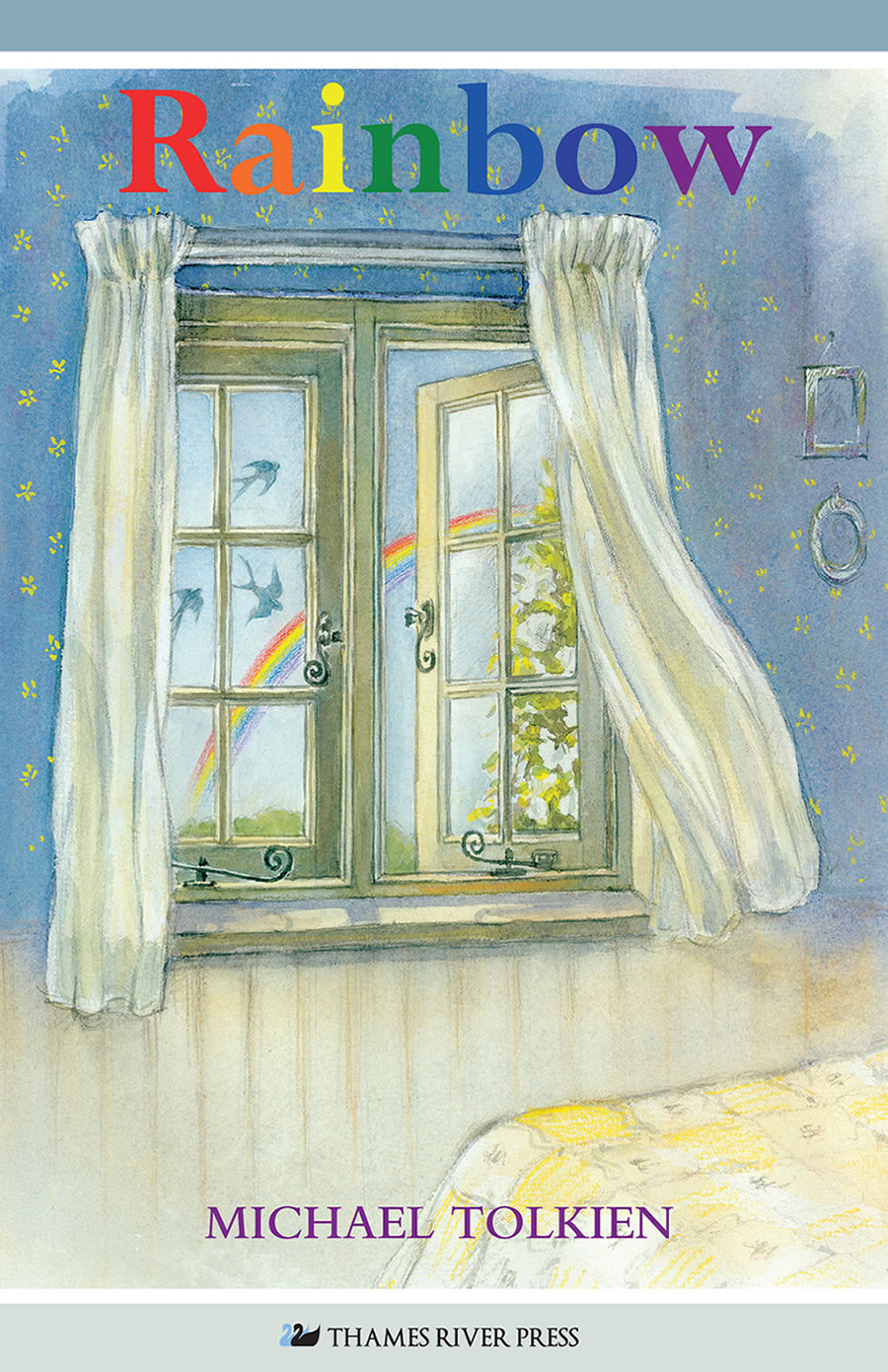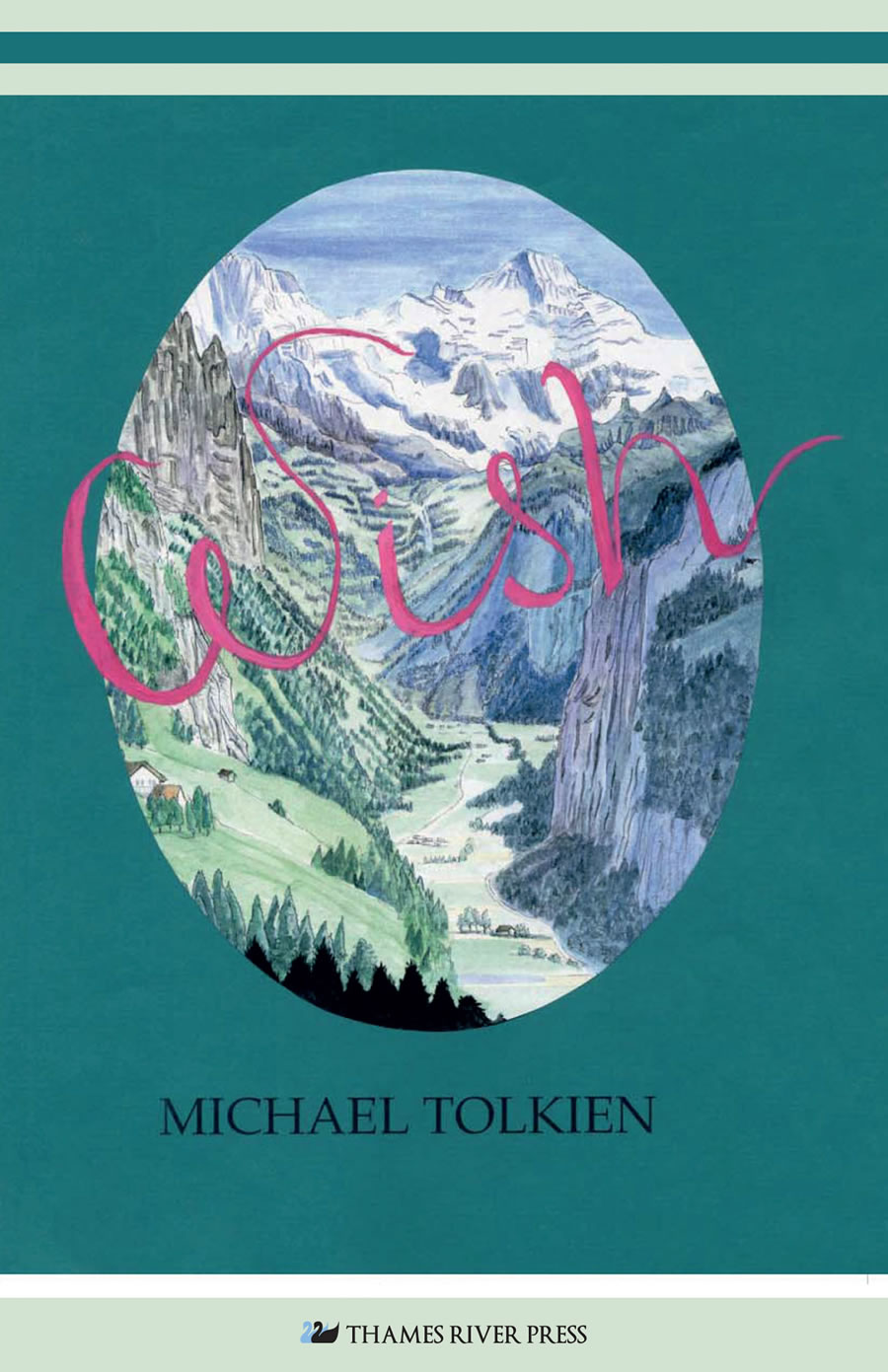Interview with Michael Tolkien about his books Rainbow and Wish (08.08.13 by Pieter Collier) -
Comments
Born in Birmingham in 1943, Michael Tolkien grew up in South Oxfordshire and North Yorkshire. He studied classics and English at St Andrews and Oxford. He has lived in Rutland since 1968 and was a secondary school teacher until early retirement in 1994. Since 1998 his verse has been published in two booklets and five full collections, most recently in 2012. His work has been widely and favourably reviewed. Two of his major themes are deceptive appearances and the conflict of active and contemplative approaches to life. This is also apparent in his recent narrative verse adaptations of Florence Bone’s now largely forgotten fantasy fiction for children.
In Rainbow, you join Grace on her journey to the other side of the rainbow as she learns to look below surfaces and to make important choices. In this whimsical and wayward tale we explore the way appearances deceive, the energies of the living world, discover new feelings of wonder and how selfless love can make lasting changes.
Wish, is the story of one family’s attempt to survive and combat the destruction meted out on their alpine farm by an embittered, stunted old man who has learnt to abuse a necklace of power to ruin growth, happiness and joy in people’s lives and in the natural world. Unexpected relief comes from the impulsive journey of two children, who nearly lose everything in their determination to quell this evil.
His experience as a verse writer enables Michael Tolkien to create fast-moving stories with many kinds of dialogue in a variety of styles. This is fantasy but set in a place with a complicated history and a challenging landscape. The relationship between people and their natural surroundings is unpredictably light-hearted, grim, or colourful. Everyone must learn that appearances deceive.
Having read both books I can only recommend Michael tolkien's work and I'm honored to be able to release an interview (below) about his two latest books Rainbow and Wish.
Rainbow
Allowed then to climb the ‘Shining Stairway’, Grace is nearer the rainbow but in more danger of being sidetracked by strange, even dangerous forces. The promised places are beautiful and intriguing but she learns to look back below the surface of her adventures and to make important choices. Suddenly back in the everyday world she is still herself but more so because she can see and understand more acutely.
Author: Michael Tolkien
Publisher: Thames River Press
Publication Date: 1 Mar 2013
Type: hardcover, 182 pages
ISBN-10: 085728648X
ISBN-13: 978-0857286482
Wish
Young Berwald and his sister Clara set out, without their parents knowing, to climb into the next valley, seize the chain, free their neighbourhood of fear, and wish for whatever they want. But they soon learn that the wild world beyond their home is full of strange forces – some good, some dark and twisted – and almost every wish they make adds new complications and disagreements.
Who can rescue them from this fearful and dangerous adventure? Before Adam, their angry and worried father, can reach them, he must learn to follow seemingly useless leads, and to listen carefully to the tale that lies behind the villain’s bitterness.
A timeless fantasy tale given new life and enchantment in this vivid retelling in verse.
Author: Michael Tolkien
Publisher: Thames River Press
Publication Date: 1 Mar 2013
Type: hardcover, 124 pages
ISBN-10: 0857281992
ISBN-13: 978-0857281999
Interview with Michael Tolkien about Rainbow and Wish
The following interview was conducted in March of 2013 (by e-mail). I wish to express my grattitude to Marie King, who works at the Publicity Department of Thames River Press, who made this possible! Further I wish to thank Michael Tolkien to free up time to answer my questions!
TL: Michael Tolkien, can you tell us a little about yourself?
MT: Please look at home page on my website michaeltolkien.com. I will refer to this several times in answering further questions. What I have stated there is as much as I wish to divulge. I prefer to be known through my work rather than snippets of diverse information.
TL: I'd like to talk about your books, Wish and Rainbow. What prompted you to write these books?
MT: In the case of Wish I wanted to pay tribute to a book I had long loved and one that was read to me by my mother in childhood. I did not know anything about F. Bone’s The Other Side of the Rainbow until I was told by an expert that it was her only other book in fantasy mode. Once read it quickly got under my skin and I tried for two years to see if I might work with it in a similar way to Wish. It absolutely defied me and insisted on being itself though in new attire.
Please refer to the prefaces of both books for enlargement on these sketchy comments. Both can be found on my website.
TL: In what does your first book Wish differ from the 1923 novel The Rose-Coloured Wish by Florence Bone?
And what does your second book Rainbow differ from the The Other Side of the Rainbow also by Florence Bone?
The best answers to these questions are to be found in the prefaces on my website. Please read The origin and writing of WISH. That explains all!
TL: Of course, being the grandson of J.R.R. Tolkien, I must ask whether you think that he had read these books by Florence Bone and if you think they had any influence on him?
I am fairly certain that J.R.R. Tolkien never encountered these books, and I really cannot speculate about how he would have reacted to them. Of course, there’s been media myth-making already. Even to the extent that my grandfather is supposed to have read Florence Bone’s tales to me!
TL: Talking about your grandfather, do you share your grandfather's love for the written word and languages?
Yes! Just once instance is to be found in the nomenclature of place names in Wish.
TL: What is your hope for your readers?
I would like to have a readership of diverse ages. This is in line with my contentions (shared with J.R.R. Tolkien’s views in his essay On Fairy Stories) that fantasy should not be regarded as a childish pastime.
See my lecture relating Rainbow to On Fairy Stoies, recently given at Loughborough to the Tolkien Society.
It is on website in full: FANTASY: delusion or wisdom?
Both of my fantasies are books for readers to read not once but at several stages in their lives and, particularly in the case of Rainbow, to find ever more resonances below the surface.
TL: Did you read J.R.R tolkien's books and if so what is your favourite?
Yes. Hopefully my lectures (see Lectures on J.R.R. Tolkien) are a tribute to that intense reading!
My favourites have always been The Silmarillion in the ingenious and scholarly compilation made by C. Tolkien, Smith of Wootton Major and Tree and Leaf.
TL: Since you are yourself an author of children books, where do you place The Hobbit?
First let me clarify. I am not primarily an author of childrens’ books. I simply found myself wanting to recreate two appealing narrative fantasies that happened to be written with children in mind. Principally I am a poet (see information about my collections on my website: Poetical Works).
All that said, I rate The Hobbit as one of the most engaging narratives in the history of modern fiction. Naturally, as it was written with my grandfather’s children in mind, it appeals to younger readers, but actually it is an essential ingredient in the whole conception and unfolding of the history of Middle-earth, a responsibility it carries off both lightly and profoundly.
TL: Since you are a poet yourself, what do think of your grand fathers' poetry?
Apart from the Tom Bombadil collection, though even that needs to be seen in its setting in The Lord of the Rings, JRRT’s poetry is largely contextual in his narratives, and I find it both memorable and technically skilful. In many cases it tends to add dimensions of atmosphere and historical resonance only hinted at in the main body of the tale.
I should add with emphasis that I greatly value and admire JRRT’s versions of Pearl, Gawain and other mediaeval poems.
TL: When I first saw the cover of Wish I was reminded of a drawing by J.R.R. Tolkien of Rivendell, is this a lucky coincidence?
The cover refers to the alpine setting in F. Bone’s original tale. That setting, which I have retained and developed in my version, generated this rather absurd speculation.
My wife, who illustrated Wish throughout, made a selection from her original sketches and paintings of the Lauterbrunnen valley in the Bernese Oberland as a model for the cover illustration. When it appeared on the internet there was delight of an almost detective-like discovery in many quarters that she had based her work on Tolkien’s own painting of Rivendell.
It’s quite possible, of course, that both artists were inspired by the same Swiss valley. But this is a different matter, and of far more significance than an assumed copying process. And it would involve establishing some careful details about Tolkien’s itinerary during his visit to Switzerland and sojourn at Grindelwald: did he ever view this valley from Wengen as did my wife and I in all its moods during our many summer holiday visits there?
Arguably, in any case, Rivendell feels both in Tolkien’s picture and how it is described in The Hobbit, an altogether more intimate and sheltered place than the vast glacial valley, and the mountains are a more distant prospect, whereas they loom up over and dominate the Lauterbrunnen Valley.
TL: You probably already went to see The Hobbit movie by Peter Jackson, how do you look towards the movie adaptation?
NO I have not yet seen the movie, but I have ordered it on DVD. I imagine I shall have mixed reactions to this, as I did to The Lord of the Rings films. In general, as before, I rather dread the treatment of elves and dwarves! And cinematic effects for their own sake are liable to be a distraction. They were certainly intrusive and excessive in the third The Lord of the Rings film. By and large, though, I have respected the work of Peter Jackson, his team, and the actors.
TL: Just out of curiosity, do you have any Tolkien books in your house and what is your biggest treasure?
You would expect me to have several editions of my grandfather’s works. Equally, in this world of competitive book trading you might imagine I do not wish to give any details.
TL: Fully understandable, indeed! To finish this interview I have one final question. Are you planning on rewriting more tales or are there any other projects you are working on?
I think it is probably easiest for me to point you in the direction of the ‘ongoing work’ section of my website.
Spread the news about this J.R.R. Tolkien article:

